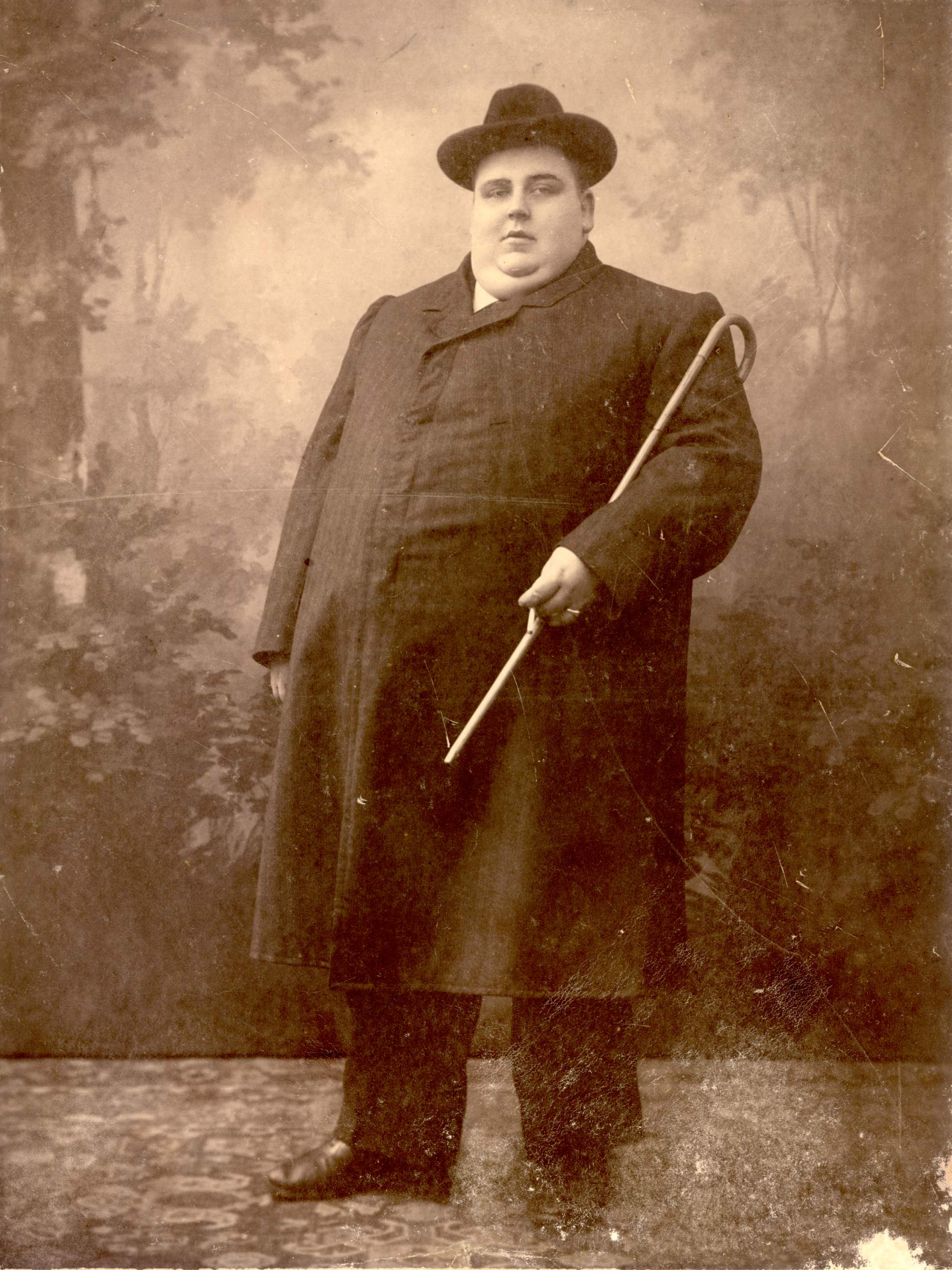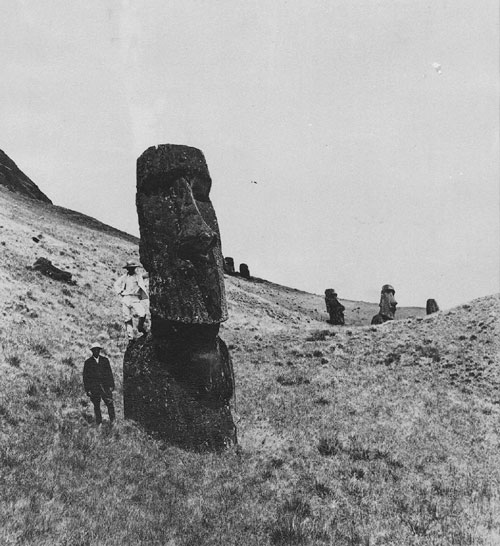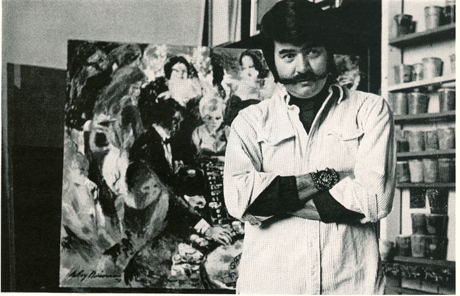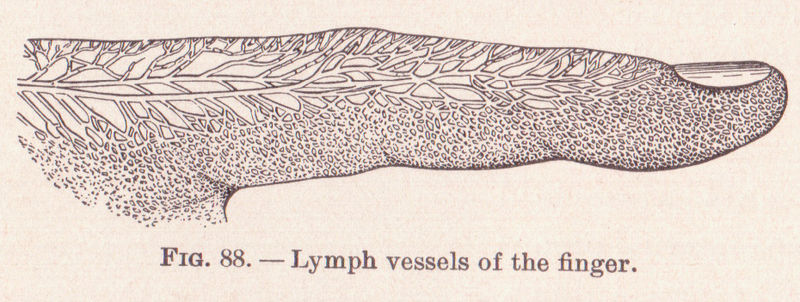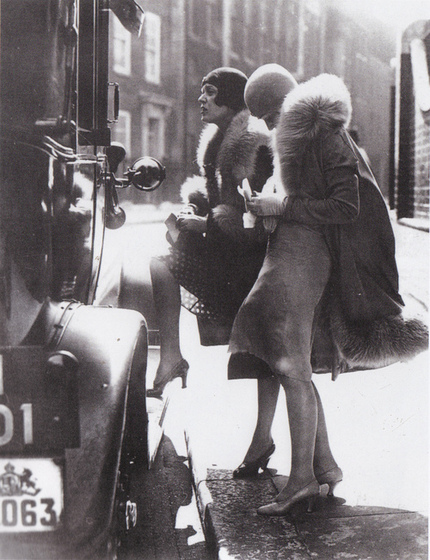A 1975 portrait of photographer Ansel Adams.
You are currently browsing the yearly archive for 2012.
Tags: Ansel Adams.
Margaret Fuller (1810-1850) was the Susan Sontag of her day–America’s original Susan Sontag, actually. The first female book critic of great acclaim, Fuller was not exactly modest about her brilliance. “I find no intellect comparable to my own,” she offered to all who would listen. She was a prominent member of Brook Farm, George Ripley’s failed experiment in Utopian living, and reportedly inspired the “Zenobia” character in Nathaniel Hawthorne’s The Blithedale Romance, who commits suicide by drowning. Fuller herself died by water, perishing in a shipwreck that she seemingly could have escaped but chose not to. Her body was never recovered. Some 35 years after her death, an odd (and likely apocryphal) story appeared about her in the Boston Traveller, which was reprinted in the September 6, 1885 Brooklyn Daily Eagle. The article in full:
“As every topic comes up at the elegant lunch and dinner tables of Newport, so I was not astonished to hear a lady say that she ‘knew of the grave of Margaret Fuller.’ Mrs. Julia Ward Howe, who was present, and who had written a life of Margaret Fuller, was astonished, as it is reputed in all the lives written of that extraordinarily resurrected person, the Marchesi Ossili, that her body never reached land. An old fisherman at Fire Island, however, told a lady who was in the habit of going there several years ago, that he found the remains of Margaret Fuller lying on the beach in her nightgown, which was marked by her name, and that he wrote to the brothers Fuller and Horace Greeley about it, without receiving any answer; that he went up to New York to see Mr. Greeley, but he seemed to take no notice of the fact; and that he then buried Margaret Fuller at Coney Island; and could identify the spot.”
From “If They Could Only Talk,” Hannah Bloch’s new National Geographic article about the elemental questions we need to ask about Easter Island:
“Easter Island covers just 63 square miles. It lies 2,150 miles west of South America and 1,300 miles east of Pitcairn, its nearest inhabited neighbor. After it was settled, it remained isolated for centuries. All the energy and resources that went into the moai—which range in height from four to 33 feet and in weight to more than 80 tons—came from the island itself. Yet when Dutch explorers landed on Easter Sunday in 1722, they met a Stone Age culture. The moai were carved with stone tools, mostly in a single quarry, then transported without draft animals or wheels to massive stone platforms, or ahu, up to 11 miles away. Tuki’s question—how did they do it?—has vexed legions of visitors in the past half century.
But lately the moai have been drawn into a larger debate, one that opposes two distinct visions of Easter Island’s past—and of humanity in general. The first, eloquently expounded by Pulitzer Prize winner Jared Diamond, presents the island as a cautionary parable: the most extreme case of a society wantonly destroying itself by wrecking its environment. Can the whole planet, Diamond asks, avoid the same fate? In the other view, the ancient Rapanui are uplifting emblems of human resilience and ingenuity—one example being their ability to walk giant statues upright across miles of uneven terrain.”
••••••••••
Leonard Nimoy applies his spooky gravitas to Easter Island, 1977:
Tags: Hannah Bloch, Jared Diamond, Leonard Nimoy
Short profile of Alex Haley in 1977, after the novel Roots made him a household name. Previously best known as an ace interviewer for Playboy, Haley would later face charges of having plagiarized passages (which the author copped to as part of an out-of-court settlement). Whatever the origins of the work and despite a simplification of the subject, the novel and subsequent TV miniseries had a powerful effect in awakening America to its past.
Read also:
- Haley interviews Miles Davis. (1962)
Tags: Alex Haley
LeRoy Neiman, a fashion-world illustrator who eventually made wealth and fame from loud, distinctive depictions of prizefighters and placekickers, just passed away. From “Leroy Neiman’s Work Reveals Him, In Some Ways, As A Carbon-paper Dali,” Pat Jordan’s largely dismissive 1975 Sports Illustrated profile of the man and his mustache:
“Neiman began his art career in sewing rooms, as a fashion illustrator for designers like Yves St. Laurent. His work appeared in Vogue, Harper’s Bazaar and Bride’s Magazine. Over the years, through persistence and the cultivation of a highly distinctive style—he is known as ‘a flamboyant colorist’—he became a personality as gaudy as those he portrays. In fact, at a poor showing of the New York Jets one Sunday in Shea Stadium, fans began to yell, ‘Put LeRoy in!’ Often, Neiman’s mere presence at an event overshadows it and the work he produces there. Such status now brings him as much as $25,000 for a painting. He is best known for his sporting canvases and lithographs.
‘LeRoy has style,’ said a publisher of coffee-table books-while sipping a drink at 21. ‘He discovered it 10 years ago and it’s made him a lot of money. He’s a very wealthy man you know, extremely. He has some beautiful suits. Still, I don’t think he’s put his soul into a painting in 10 years.’
At 44, Neiman has a lion’s mane of lustrous black hair, a surprisingly wispy, up-curled mustache and pale, puffy good looks. Perpetually clamped between his teeth or propped between his fingers is a long, thin cigar the length of an artist’s paintbrush. Maddeningly, the cigar never seems to diminish. Like plastic firewood, it appears to be an electronic prop that never sheds an ash.
Neiman’s friend and mentor, Salvador Dali, is also a believer in image-making props and elaborate mustaches, and, like Dali, Neiman has been accused by critics of expending more energy on the creation of his public character than on his art.”
Tags: LeRoy Neiman, Pat Jordan, Salvador Dali
From the April 19, 1876 Brooklyn Daily Eagle:
“This morning Officer Maloney of the Washington Street Precinct found a human finger lying in the gutter in front of No. 310 Hicks Street. The finger appears to have been chopped off with some sharp instrument, and does not look as though it had been amputated.”
Tags: Officer Maloney
Eugene Selznick, who just passed away, was one of the fathers of American volleyball and no slouch at ballyhoo, either. He recruited basketball legend Wilt Chamberlain to play on a tour in the early 1970s, which helped further popularize the game and make it an Olympic sport. An excerpt from Selznick’s New York Times obituary, which was written by Paul Vitello:
“Chamberlain, the 7-foot-1 N.B.A. star, was near the end of his basketball career in the early 1970s when he took up beach volleyball to help rehabilitate his battered body. Selznick proceeded to cajole Chamberlain into joining him and other top players for a nationwide exhibition tour in the summer of 1973, the year he retired from basketball.
The publicity generated by the Chamberlain tour, as it was known, brought a new generation to volleyball and laid the groundwork for a boom in popularity that began in the ’80s. Beach volleyball became an official Olympic sport in 1996. Selznick coached the men’s Olympic beach volleyball team of Sinjin Smith and Carl Henkel to a fifth-place finish in Atlanta in 1996, and the women’s Olympic team of May-Treanor and McPeak to fifth place in Sydney in 2000.”
••••••••••
Home-movie footage from the Chamberlain-Selznick tour.
Chamberlain visits Ed Sullivan after scoring 100 points in a game, 1962.
If you want an apocalypse with amenities, Survival Condo is for you. While others are dying from infections to their searing flesh, you’ll be poolside below the earth in a luxury condo development. From D.C. Stewart’s new Discover piece about the post-apocalyptic playground:
“Larry Hall, a former software engineer who bought his 174-foot-deep hole in the ground from the government for $300,000 in 2008, plans to convert it to calamity-proof condos by 2013. The silo is one of 72 built across the country to deter a Soviet attack during the Cold War. Tucked into an empty stretch of rural Kansas, it once housed an Atlas F nuclear ballistic missile that could travel more than 7,000 miles. To withstand a Soviet strike, the silo’s concrete walls are up to nine feet thick. But it’s not some ‘dreary concrete basement hideaway,’ Hall assures visitors to his website, survivalcondo.com. It’s a place to enjoy ‘the coolness of a missile base, the protection of a nuclear-hardened bunker, and the features of a luxury condo.'”
••••••••••
“Well meet again / Don’t know where / Don’t know when”:
Tags: Larry Hall
Tags: Michio Kaku
From Alexis Madrigal’s new Atlantic article about Facebook’s attempt to govern its “nation” of users, a succinct description of the origins of technocracy:
“The original technocrats were a group of thinkers and engineers in the 1930s who revived Plato’s dream of the philosopher-king, but with a machine-age spin. Led by Thorstein Veblen, Howard Scott and M. King Hubbert, they advocated not rule by the people or the monarchy or the dictator, but by the engineers. The engineers and scientists would rule rationally and impartially. They would create a Technocracy that functioned like clockwork and ensured the productivity of all was efficiently distributed. They worked out a whole system by which the North American continent would be ruled with functional sequences that would allow the Continental Director to get things done.
Technocracy, as originally conceived, was explicitly not democratic. Its proponents did not want popular rule; they wanted rule by a knowledgeable elite who would make good decisions. And maybe they would have, but there was one big problem. Few people found the general vision of surrendering their political power to engineers all that appealing.”
Tags: Alexis Madrigal, Howard Scott, M. King Hubbert, Thorstein Veblen

“The fashion of wearing birds in the hat is, it seems, to continue in spite of its cruelty and its shortsightedness.”
A 1880s/90s fashion trend whereby women wore bird feathers and sometimes entire stuffed birds in their hats as ornaments meant trouble for woodpeckers and such. Song birds were legally protected but milliners coveted them regardless, so it was off with their heads. Until their heads could be stuffed and sewn back on and placed on a hat, that is. Numerous editorial writers and preservationists railed against the idiotic fashion until it finally abated. From the September 23, 1886 Brooklyn Daily Eagle:
“The youthful gunners of Astoria and Bushwick and other outlying regions north of Brooklyn have suddenly discovered the presence in the woods and gardens of numerous woodpeckers, and have committed great havoc among them, although these birds are among those which the state considers as song birds and protects by special statute. But the fashion of wearing birds in the hat is, it seems, to continue in spite of its cruelty and its shortsightedness. Many small birds, and particularly those of the woodpecker family, are insectivorous, and under the greatest services to humanity by unremitting war upon our insect pests. The shade trees of Kings County have suffered so terribly this Summer from the saw fly, the borer and the din beetle, that many horticulturists have been almost driven to despair. And now when some of these wretched creatures are hibernating, particularly the din beetle that infests our elm trees, and fall an easy prey to insectivorous birds the sound sense of the law becomes plainly manifest, and its observation in the most stringent manner is of paramount importance. Yet it is not observed, and young lads have been seen in the streets of Astoria with scores of these beautiful and yellow shafted flicker and the downy woodpecker, all of which have been butchered to adorn the hats of ladies. And it is to be feared that as long as milliners find a sale for such hats. so long will they give big prices to the young fellows in Long Island.”
Tags: Buckminster Fuller
Steven Pinker has an essay Edge in which he counters evolutionary scientists who support group selection theory. The opening:
“Human beings live in groups, are affected by the fortunes of their groups, and sometimes make sacrifices that benefit their groups. Does this mean that the human brain has been shaped by natural selection to promote the welfare of the group in competition with other groups, even when it damages the welfare of the person and his or her kin? If so, does the theory of natural selection have to be revamped to designate ‘groups’ as units of selection, analogous to the role played in the theory by genes?
Several scientists whom I greatly respect have said so in prominent places. And they have gone on to use the theory of group selection to make eye-opening claims about the human condition. They have claimed that human morailty, particularly our willingness to engage in acts of altruism, can be explained as an adaptation to group-against-group competition. As E. O. Wilson explains, “In a group, selfish individuals beat altruistic individuals. But, groups of altruistic individuals beat groups of selfish individuals.” They have proposed that group selection can explain the mystery of religion, because a shared belief in supernatural beings can foster group cohesion. They suggest that evolution has equipped humans to solve tragedies of the commons (also known as collective action dilemmas and public goods games), in which actions that benefit the individual may harm the community; familiar examples include overfishing, highway congestion, tax evasion, and carbon emissions. And they have drawn normative moral and political conclusions from these scientific beliefs, such as that we should recognize the wisdom behind conservative values, like religiosity, patriotism, and puritanism, and that we should valorize a communitarian loyalty and sacrifice for the good of the group over an every-man-for-himself individualism.
Tags: E.O Wilson, Steven Pinker
A bunch of my favorite articles from the first half of 2012. All available for free.
- “Of Flying Cars and the Declining Rate of Profit” (David Graeber, The Baffler): The anthropologist explains why we never truly entered the Space Age.
- “How to Survive the End of the Universe,” (Andrew Grant, Discover): Fascinating account of how humans can escape oblivion as our solar system changes over the next few billion years.
- “Was Frankenstein Really About Childbirth?“ (Ruth Franklin, The New Republic): Provocative piece that makes a strong case that the dread of childbirth was a major impetus for Mary Shelley’s classic.
- “One’s a Crowd” (Eric Kleinberg, The New York Times): Great Op-Ed piece about the increasing number of people living alone.
- “How the U.S. Lost Out on iPhone Work” (Charles Duhigg and Keith Bradsher, The New York Times): A deep and penetrating explanation of the complicated forces at play in job outsourcing.
- “The Power of Habit“ (Charles Duhigg, Slate): An excerpt from the author’s bestseller of the same name which explains how Pepsodent became omnipresent.
- “We’re Underestimating the Risk of Extinction” (Ross Andersen, The Atlantic): I didn’t necessarily agree with the premise (or conclusions) of this interview with philosopher Nick Bostrom, but I enjoyed its intelligence immensely.
- “A Universe of Self-Replicating Code” (George Dyson, Edge): The science historian presents a far-ranging commentary on the beginnings of our Digital Age.
- “David Edmonds on Ethical Problems” (The Browser): Excellent interview with the BBC radio producer about books that deal with moral philosophy.
- “Hustling the Cloud” (Steven Boone, Capital New York): Wonderful piece about a bleary-eyed, middle-of-the-night search for free Wi-Fi–and anything else that would seem to make sense–in a time of dire economic straits.
- “Craig Venter’s Bugs Might Save the World” (Wil S. Hylton, The New York Times Magazine): Fascinating examination of the titular biologist, who wants to make breathing bots that will cure the world’s ills.
- “Zap Your Brain Into the Zone” (Sally Adee, New Scientist): The technology writer has her gray matter enhanced.
- “The Man Who Saves Stephen Hawking’s Voice” (Catherine de Lange, New Scientist): An interesting account of why the famed physicist sounds the way he does and the trying task of keeping his voice the same.
- “The Secret Life of a Society Maven” (Alan Feuer, The New York Times): The journalist finally learns the truth about his namesake’s muddled past.
- “Spacesuit: An Interview with Nicholas de Monchaux” (BLDG BLOG): A really fun talk with the architect about his history of NASA’s Apollo gear.
Tags: Alan Feuer, Andrew Grant, Catherine de Lange, Charles Duhigg, David Graeber, Eric Kleinberg, George Dyson, Keith Bradsher, Ross Andersen, Ruth Franklin, Sally Adee, Steven Boone, Wil S. Hylton
For its 150th anniversary, Timex sponsored “The Future of Time,” a competition that imagined timepieces 150 years from now. One entry was a thumbnail watch. From the competition copy: “TX54 is a disposable timepiece that is worn on the user’s thumbnail. While its translucency makes it blend seamlessly with the hand, a selection of text color options and a glow feature that activates on command make it easy to read.”
••••••••••
Live Timex commercial for the waterproof version:
From a new Venue interview with Edward Burtynsky, the brilliant photographer of industrial landscapes, a passage about learning self-editing:
“Burtynsky: I love the tones of browns and grays—I love more neutral tones. That’s why I like going to the desert and working in the desert. I find that green trees and things like that have a tendency to lock us into a certain way of seeing. When I look at green trees on a sunny day, I don’t know how to make an interesting picture of that. We’re familiar with that already.
Instead, I like the transparency that comes when leaves are off and you can look deeper into the landscape—you can look through the landscape. When I did try to make those kind of green-tree/sunny-day pictures, I’d find myself not ever putting them up and not ever using them. Eventually, I just said, well, I’m not going to take them anymore, because they never make it past the edit.
There’s a certain point where you learn from your own editing. You just stop taking certain pictures because they never make it through. Your editing starts to inform your thinking, as far as where you want to go and what you want to look for when you’re making a photograph.
That what’s different about me after thirty years of doing this kind of work—there are a lot of pictures I don’t have to take anymore. I think that’s called wisdom—learning what not to waste your time on!”
•••••••••••
Manufactured Landscapes, 2006:
Tags: Edward Burtynsky
John Cook and Hamilton Nolan are consistently good reads at Gawker. The former can sometimes be extreme–his takedown of Mike Wallace went too far, I think–but even in his excess a lot can be learned. Here’s the opening of Cook’s reconsideration of those Watergate wonders Woodward and Bernstein:
“Bob Woodward and Carl Bernstein’s investigation into the origins of the Watergate break-in—which took place 40 years ago yesterday—is one of the most highly mythologized episodes in the history of journalism. It represents the Platonic ideal of what journalism-with-a-capital-J ought to be, at least according to its high priesthood—sober, careful young men doggedly following the story wherever it leads and holding power to account, without fear or favor. It was also a sloppy, ethically dubious project the details of which would mortify any of the smug high priests of journalism that flourished in its wake. The actual Watergate investigation could never have survived the legacy it helped create.”
Tags: Bob Woodward, Carl Bernstein, Hamilton Nolan, John Cook, Mike Wallace
Product development is endlessly fascinating and nothing amuses more than truly terrible products that were brought to the market. A lot of very intelligent people thought they sounded like good ideas at the time. Or maybe they were initially good ideas that just got away from them. From Oliver Burkeman’s Guardian article about his recent visit to a storehouse of failed consumer products in Ann Arbor:
“This is consumer capitalism’s graveyard – the shadow side to the relentlessly upbeat, success-focused culture of modern marketing. Or to put it less grandly: it’s almost certainly the only place on the planet where you’ll find Clairol’s A Touch of Yogurt shampoo alongside Gillette’s equally unpopular For Oily Hair Only, a few feet from a now-empty bottle of Pepsi AM Breakfast Cola (born 1989; died 1990). The museum is home to discontinued brands of caffeinated beer; to TV dinners branded with the logo of the toothpaste manufacturer Colgate; to self-heating soup cans that had a regrettable tendency to explode in customers’ faces; and to packets of breath mints that had to be withdrawn from sale because they looked like the tiny packages of crack cocaine dispensed by America’s street drug dealers. It is where microwaveable scrambled eggs – pre-scrambled and sold in a cardboard tube with a pop-up mechanism for easier consumption in the car – go to die.
There is a Japanese term, mono no aware, that translates roughly as ‘the pathos of things’: it captures a kind of bittersweet melancholy at life’s impermanence – that additional beauty imparted to cherry blossoms, say, or human features, as a result of their inevitably fleeting time on Earth. It’s only stretching the concept slightly to suggest that this is how the museum’s proprietor, an understatedly stylish GfK employee named Carol Sherry, feels about the cartons of Morning Banana Juice in her care, or about Fortune Snookies, a short-lived line of fortune cookies for dogs. Every failure, the way she sees it, embodies its own sad story on the part of designers, marketers and salespeople. It is never far from her mind that real people had their mortgages, their car payments and their family holidays riding on the success of products such as A Touch of Yogurt.” (Thanks Browser.)
••••••••••
“FOHO–It’s not just a lot of detergent”:
Tags: Oliver Burkeman
A look at the Airpod prototype, a $10K alternative vehicle that runs on oxygen. I still prefer the electric, enclosed, self-balancing motorcycle, but this one is even cleaner. It’s not, however, likely to be the future of urban transportation unless, say, China decides to put its will behind the French-built engine.
This horrifying classic photograph was taken sometime during May 1871, when members of the failed Paris Commune uprising were executed en masse. An estimated 20,000 Communards faced the firing squad and thousands more were jailed or deported. The heady two months of Socialist rebellion ended with scores of lifeless citizens who resembled broken dolls returned to their boxes. From an eyewitness account of a triple execution of revolutionaries who had been convicted of murder, which first appeared in the London Daily Telegraph and was reprinted in the New York Times on June 10, 1872:
“The priest, going up to each in turn, kissed him on both cheeks, in what seemed to me a hurried and perfunctory manner. Then, while the sentence was being read to the prisoners in a quick, low, quite inaudible tone, BOIN made a long harangue, much of which was lost in the perpetual rolling of those ghastly drums. But one could distinguish snatches of sentences such as ‘Soldiers, you are children of the people as we are, and we will show you how children of the people can die. Nous mourons innocents,’ and then opening wide his light coat–he wore no waistcoat–he offered white shirt-front for a mark, and striking his heart with his open palm, he exclaimed: ‘Portez armes en joue! feu! tirez au coeur!’ This he repeated several times, and while he was yet speaking, standing out clear away from the poteaux, and looking death at ten paces literally in the face, a sword flashed in the sun, and the three men leaped from the ground only to fall to it in horrible contortions. The smoke and the report were unheeded, for all the senses of the horrified spectator were arrested by the awful spectacle of writhing limbs and twisting hands. BOIN seemed to be rewarded for his bravery by suffering less than the others, but SERIZIER literally rolled over, and BOUDIN also moved. The surgeon then went up, examined BOUDIN first, and then directed one of the sergeants in reserve to give the coup de grace in the ear. Then SERIZIER was examined and treated in the same way; and lastly, after a considerable interval, BOIN was dragged into position and dispatched. I cannot give you any idea of the sickening impression produced by this seemingly deliberate butchery. I can say seemingly, for the men may have been dead, but, in any case, surely if the coup de grace must be given, it should be done at once. I did not time the proceedings, but, long as my description is, I believe not more than two minutes elapsed from the time that the ambulance wagons came on to the ground to the time that the volley was fired. Several more minutes, however, elapsed before the dull thud of the last coup de grace delivered a bout pontant right into the poor wretch’s ear stuck upon the ground. I have seen something of the horrors of war at Sedan and Strasbourg; I have witnessed the degradation of a public hanging in England, but have never seen anything so horrible as this supplemental butchery of the coup de grace.“
Tags: Boin, Boudin, Communards, Serizier
How do I find an overnight job in NYC?
I am seeking an overnight job in New York City, because I am returning to college full-time in the fall. I am an older student with a college degree, but decided to return to school to enhance my skills. Finding a day job is difficult because of my class schedule. I sent resumes to numerous hotels and retail stores for overnight work, but received no response. I thought about working as a barback at a dance or strip club, but I have no experience.
Any advice would be helpful!
Thank you!
From “In the Air,”‘ Malcolm Gladwell’s 2008 New Yorker assault on the Great Man Theory, a thumbnail portrait of Nathan Myhrvold, a legend at Microsoft, a company that didn’t exactly have original ideas:
“Myhrvold is of Nordic extraction, and he looks every bit the bearded, fair-haired Viking—not so much the tall, ferocious kind who raped and pillaged as the impish, roly-poly kind who stayed home by the fjords trying to turn lead into gold. He is gregarious, enthusiastic, and nerdy on an epic scale. He graduated from high school at fourteen. He started Microsoft’s research division, leaving, in 1999, with hundreds of millions. He is obsessed with aperiodic tile patterns. (Imagine a floor tiled in a pattern that never repeats.) When Myhrvold built his own house, on the shores of Lake Washington, outside Seattle—a vast, silvery hypermodernist structure described by his wife as the place in the sci-fi movie where the aliens live—he embedded some sixty aperiodic patterns in the walls, floors, and ceilings. His front garden is planted entirely with vegetation from the Mesozoic era. (‘If the Jurassic Park thing happens,’ he says, ‘this is where the dinosaurs will come to eat.’) One of the scholarly achievements he is proudest of is a paper he co-wrote proving that it was theoretically possible for sauropods—his favorite kind of dinosaur—to have snapped their tails back and forth faster than the speed of sound.”
Tags: Malcolm Gladwell, Nathan Myhrvold



